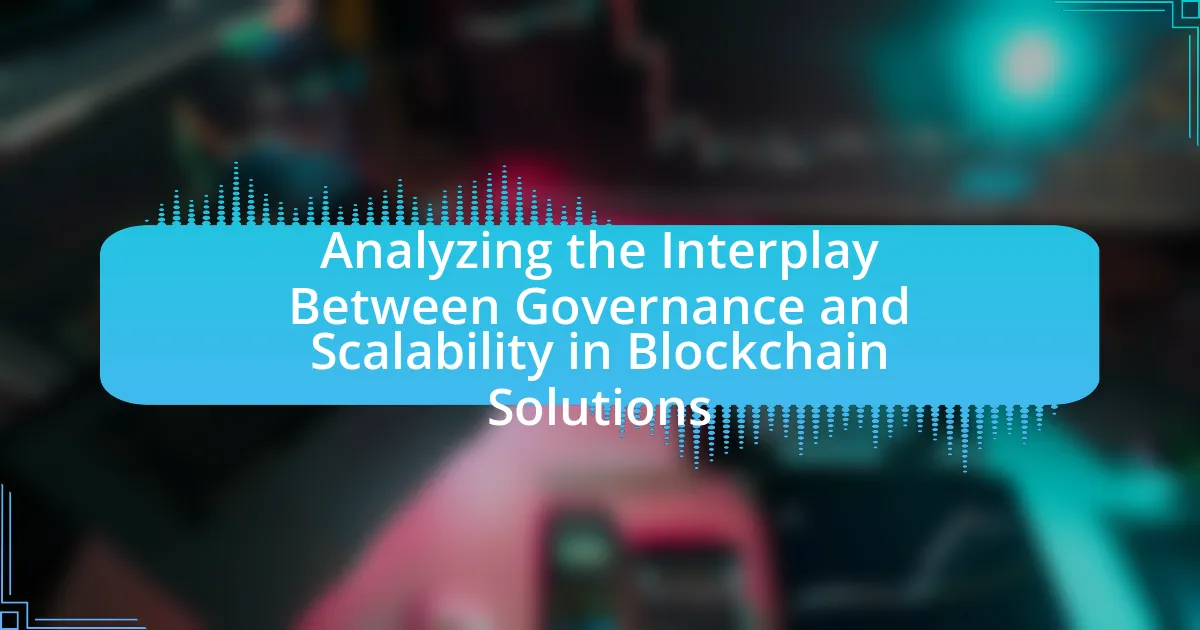The article examines the challenges of implementing governance protocols in public and private blockchains, highlighting key issues such as decentralization, stakeholder engagement, and regulatory compliance. It contrasts the governance structures of public blockchains, which emphasize inclusivity and decentralized decision-making, with private blockchains that prioritize efficiency and centralized control. The article also discusses the fundamental principles of governance in both types of blockchains, the varying interests of stakeholders, and the impact of transparency on governance effectiveness. Additionally, it addresses specific obstacles faced by each type of blockchain, including compliance challenges and trust issues, while proposing best practices to enhance governance frameworks.

What are the key challenges in implementing governance protocols in public vs. private blockchains?
The key challenges in implementing governance protocols in public versus private blockchains include decentralization, stakeholder engagement, and regulatory compliance. Public blockchains face difficulties in achieving consensus among a diverse group of stakeholders, which can lead to slower decision-making processes. For instance, Bitcoin’s governance struggles with community disagreements on protocol changes illustrate this challenge. In contrast, private blockchains often deal with issues related to trust and transparency among a limited number of participants, as seen in enterprise blockchain implementations where stakeholders may have conflicting interests. Additionally, regulatory compliance poses unique challenges; public blockchains must navigate a complex landscape of regulations that can vary by jurisdiction, while private blockchains must ensure that their governance structures align with corporate governance standards and legal requirements.
How do governance protocols differ between public and private blockchains?
Governance protocols differ significantly between public and private blockchains primarily in terms of accessibility and decision-making authority. Public blockchains, such as Bitcoin and Ethereum, utilize decentralized governance where any participant can propose changes and vote on protocol upgrades, fostering a democratic process. In contrast, private blockchains, like Hyperledger Fabric, have centralized governance structures where a limited number of pre-selected entities control decision-making, often leading to faster consensus but reduced transparency. This distinction is crucial as it affects how changes are implemented and the level of trust among participants, with public blockchains emphasizing inclusivity and private blockchains prioritizing efficiency and control.
What are the fundamental principles of governance in public blockchains?
The fundamental principles of governance in public blockchains include decentralization, transparency, consensus, and inclusivity. Decentralization ensures that no single entity has control over the network, promoting resilience and reducing the risk of manipulation. Transparency allows all participants to view transactions and governance decisions, fostering trust among users. Consensus mechanisms, such as Proof of Work or Proof of Stake, facilitate agreement on the state of the blockchain, ensuring that all participants validate transactions collectively. Inclusivity encourages participation from a diverse range of stakeholders, allowing for a broader representation of interests and ideas in governance decisions. These principles are essential for maintaining the integrity and functionality of public blockchains, as evidenced by the operational frameworks of established networks like Bitcoin and Ethereum.
What are the fundamental principles of governance in private blockchains?
The fundamental principles of governance in private blockchains include centralized control, defined access permissions, and consensus mechanisms tailored to specific stakeholders. Centralized control allows a designated authority to make decisions regarding protocol changes and network management, ensuring efficiency and accountability. Defined access permissions restrict participation to authorized entities, enhancing security and compliance with regulatory requirements. Consensus mechanisms, such as Practical Byzantine Fault Tolerance (PBFT), are often employed to facilitate agreement among a limited number of trusted participants, optimizing transaction speed and reducing resource consumption. These principles collectively enable private blockchains to maintain integrity and operational effectiveness while addressing the unique challenges of governance compared to public blockchains.
Why is stakeholder engagement crucial in governance protocols?
Stakeholder engagement is crucial in governance protocols because it ensures that diverse perspectives and interests are considered, leading to more effective decision-making. Engaging stakeholders fosters transparency and accountability, which are essential for building trust in governance systems. For instance, research by the World Economic Forum highlights that inclusive stakeholder participation can enhance the legitimacy of governance frameworks, particularly in blockchain environments where trust is paramount. Additionally, studies indicate that organizations with strong stakeholder engagement practices experience higher levels of compliance and satisfaction, ultimately contributing to the success of governance protocols.
How do stakeholder interests vary in public blockchains?
Stakeholder interests in public blockchains vary significantly based on their roles and objectives. For instance, developers prioritize network security and scalability to enhance user experience, while miners focus on transaction fees and block rewards for economic incentives. Users, on the other hand, seek transparency and decentralization to ensure trust in the system. Additionally, investors are interested in the potential for value appreciation and market stability. These varying interests can lead to conflicts, particularly when governance decisions impact the economic model or operational protocols of the blockchain, as seen in instances like the Ethereum hard fork in 2016, where differing stakeholder priorities resulted in a split in the community.
How do stakeholder interests vary in private blockchains?
Stakeholder interests in private blockchains vary primarily based on their roles and objectives within the network. For instance, enterprises often prioritize data privacy and control, seeking to limit access to sensitive information, while regulators may focus on compliance and oversight to ensure legal adherence. Additionally, developers are interested in the technical aspects, such as scalability and security, which can influence the blockchain’s architecture. These differing interests can lead to conflicts, as the need for transparency from some stakeholders may clash with the privacy demands of others. Research indicates that effective governance frameworks must balance these diverse interests to ensure the blockchain’s success and sustainability.
What role does transparency play in governance protocols?
Transparency is crucial in governance protocols as it fosters trust and accountability among stakeholders. In the context of public and private blockchains, transparency ensures that all participants can access and verify the rules and decisions made within the governance framework. This openness helps to mitigate risks of corruption and mismanagement, as evidenced by studies showing that transparent governance structures lead to higher levels of stakeholder engagement and satisfaction. For instance, a report by the World Economic Forum highlights that transparent governance in blockchain projects can enhance collaboration and innovation, ultimately leading to more effective outcomes.
How does transparency impact public blockchain governance?
Transparency significantly enhances public blockchain governance by fostering trust and accountability among participants. In public blockchains, all transactions and governance decisions are visible to every participant, which reduces the likelihood of fraud and manipulation. For instance, the Bitcoin blockchain allows anyone to verify transactions, ensuring that no single entity can alter the transaction history without consensus. This visibility encourages active participation and collaboration, as stakeholders can monitor governance processes and outcomes. Furthermore, studies have shown that increased transparency correlates with higher user engagement and satisfaction, as participants feel more informed and empowered in decision-making processes.
How does transparency impact private blockchain governance?
Transparency enhances private blockchain governance by fostering trust among participants and ensuring accountability in decision-making processes. In private blockchains, where access is restricted to a select group of entities, transparency allows stakeholders to verify transactions and governance actions, thereby reducing the risk of fraud and manipulation. For instance, a study by the World Economic Forum highlights that transparent governance mechanisms can lead to improved stakeholder engagement and compliance, as participants are more likely to adhere to protocols when they can observe and understand the governance framework. This increased visibility not only strengthens the integrity of the blockchain but also promotes a collaborative environment, essential for effective governance.

What are the specific obstacles faced in public blockchain governance?
Public blockchain governance faces several specific obstacles, including decentralization challenges, lack of consensus mechanisms, and regulatory uncertainty. Decentralization complicates decision-making processes, as diverse stakeholders may have conflicting interests, leading to gridlock. The absence of effective consensus mechanisms can hinder timely updates and improvements to the blockchain protocol, as seen in instances like Bitcoin’s scaling debates. Additionally, regulatory uncertainty creates difficulties in establishing clear governance frameworks, as varying jurisdictions may impose different rules, impacting the blockchain’s operation and adoption.
How does decentralization affect governance challenges in public blockchains?
Decentralization complicates governance challenges in public blockchains by distributing decision-making authority among a wide array of participants, which can lead to conflicts and inefficiencies. In public blockchains, such as Bitcoin and Ethereum, the lack of a central authority means that governance relies on consensus mechanisms, which can be slow and contentious, as seen in the debates over Ethereum’s hard forks. Additionally, the diverse interests of stakeholders, including miners, developers, and users, can create difficulties in reaching agreements on protocol changes, as evidenced by the contentious discussions surrounding Ethereum Improvement Proposals (EIPs). This decentralized structure can also hinder accountability, making it challenging to implement effective governance frameworks that ensure compliance and address disputes.
What are the implications of consensus mechanisms on governance?
Consensus mechanisms significantly influence governance structures within blockchain networks by determining how decisions are made and validated. In public blockchains, mechanisms like Proof of Work or Proof of Stake promote decentralization, allowing a broader range of participants to influence governance, which can lead to more democratic decision-making but may also result in slower consensus and potential conflicts among stakeholders. Conversely, private blockchains often utilize consensus mechanisms that favor speed and efficiency, such as Practical Byzantine Fault Tolerance, which centralizes governance among a limited number of trusted entities, potentially leading to quicker decisions but at the cost of reduced transparency and inclusivity. These dynamics illustrate that the choice of consensus mechanism directly impacts the balance between decentralization and efficiency in governance, shaping how power and authority are distributed within the network.
How do scalability issues influence governance in public blockchains?
Scalability issues significantly influence governance in public blockchains by limiting transaction throughput and increasing latency, which can hinder decision-making processes. When a blockchain network struggles to handle a high volume of transactions, it can lead to delays in governance actions, such as voting or protocol upgrades. For instance, during periods of congestion, the time required for participants to reach consensus may extend, thereby complicating the implementation of governance proposals. Additionally, scalability challenges can exacerbate centralization tendencies, as larger entities may dominate the network due to their ability to process transactions more efficiently, undermining the decentralized governance model that public blockchains aim to uphold. This dynamic is evidenced by the Ethereum network’s congestion during the DeFi boom in 2020, which highlighted the difficulties in executing governance decisions promptly amidst high transaction fees and slow processing times.
What regulatory challenges exist for public blockchain governance?
Public blockchain governance faces significant regulatory challenges primarily due to the lack of a clear legal framework. This ambiguity leads to difficulties in compliance with existing laws, such as securities regulations, anti-money laundering (AML) requirements, and data protection laws. For instance, the U.S. Securities and Exchange Commission (SEC) has classified certain cryptocurrencies as securities, which imposes stringent reporting and compliance obligations on blockchain projects. Additionally, the decentralized nature of public blockchains complicates the enforcement of regulations, as there is often no central authority to hold accountable. This regulatory uncertainty can hinder innovation and investment in blockchain technologies, as companies may be reluctant to engage in projects that could be deemed non-compliant or face legal repercussions.
How do varying jurisdictions impact governance protocols?
Varying jurisdictions significantly impact governance protocols by creating diverse regulatory environments that influence how blockchain systems operate. Different countries or regions may impose unique legal requirements, compliance standards, and operational restrictions, which can lead to inconsistencies in governance practices. For instance, the European Union’s General Data Protection Regulation (GDPR) mandates strict data privacy measures, affecting how blockchain networks handle personal data, while jurisdictions like the United States may have more lenient regulations. This divergence necessitates that blockchain developers and organizations adapt their governance protocols to align with local laws, potentially complicating cross-border operations and interoperability among different blockchain systems.
What are the compliance challenges faced by public blockchains?
Public blockchains face significant compliance challenges primarily due to their decentralized nature, which complicates adherence to regulatory frameworks. The lack of a central authority makes it difficult to implement Know Your Customer (KYC) and Anti-Money Laundering (AML) regulations, as these require the identification and verification of users. Additionally, the pseudonymous nature of transactions on public blockchains can hinder the ability to trace illicit activities, leading to potential legal repercussions for operators and developers. Furthermore, varying regulations across jurisdictions create a complex landscape for compliance, as public blockchains often operate globally, making it challenging to meet diverse legal requirements.

What are the specific obstacles faced in private blockchain governance?
Private blockchain governance faces specific obstacles including centralization of control, lack of transparency, and challenges in stakeholder consensus. Centralization occurs because a limited number of entities often manage the network, which can lead to power imbalances and reduced trust among participants. Lack of transparency is a significant issue, as private blockchains may not disclose all governance processes, making it difficult for stakeholders to understand decision-making. Additionally, achieving consensus among diverse stakeholders can be challenging, as differing interests and priorities may hinder collaborative governance efforts. These obstacles can undermine the effectiveness and credibility of private blockchain systems.
How does centralization influence governance challenges in private blockchains?
Centralization significantly influences governance challenges in private blockchains by concentrating decision-making authority within a limited group of stakeholders. This concentration can lead to issues such as lack of transparency, reduced accountability, and potential conflicts of interest, as the governing body may prioritize its own objectives over the broader network’s needs. For instance, in private blockchains like Hyperledger Fabric, governance is often managed by a consortium of organizations, which can create power imbalances and hinder collaborative decision-making. Additionally, centralization can stifle innovation and adaptability, as changes to governance protocols may require consensus from a small number of entities, making it difficult to respond to evolving market demands or regulatory requirements.
What are the implications of limited stakeholder participation on governance?
Limited stakeholder participation in governance leads to reduced accountability and transparency. When stakeholders are not actively involved, decision-making processes may lack diverse perspectives, resulting in policies that do not reflect the needs or interests of the broader community. This can foster distrust among stakeholders and diminish the legitimacy of governance structures. Research indicates that inclusive governance models, such as those highlighted in the “World Bank Governance Indicators,” show that higher stakeholder engagement correlates with improved governance outcomes, including enhanced public trust and compliance. Therefore, limited participation can undermine the effectiveness and credibility of governance systems, particularly in the context of blockchain implementations where community trust is essential for success.
How do trust issues affect governance in private blockchains?
Trust issues significantly undermine governance in private blockchains by creating skepticism among participants regarding the integrity and transparency of the system. In private blockchains, where a limited number of entities control the network, the lack of decentralization can lead to concerns about potential manipulation or biased decision-making by those in power. For instance, if stakeholders doubt the fairness of governance protocols, they may resist participating in consensus processes, leading to inefficiencies and conflicts. Research indicates that trust is a critical factor in the adoption and effectiveness of blockchain technologies, as highlighted in the study “Trust in Blockchain Technology: A Systematic Literature Review” by authors such as Xu et al. (2020), which emphasizes that trust directly influences user engagement and governance outcomes.
What are the security and privacy concerns in private blockchain governance?
Security and privacy concerns in private blockchain governance primarily revolve around access control, data confidentiality, and the potential for insider threats. In private blockchains, where a limited number of participants have permissioned access, the risk of unauthorized access increases if governance protocols are not robust. Additionally, sensitive data stored on the blockchain may be exposed to participants who do not require access, leading to privacy violations. Insider threats are also a significant concern, as individuals within the organization may exploit their access to manipulate data or governance processes. According to a report by the World Economic Forum, 70% of organizations implementing blockchain technology cite security as a primary concern, highlighting the critical need for effective governance frameworks to mitigate these risks.
How do data privacy regulations impact governance protocols?
Data privacy regulations significantly impact governance protocols by necessitating stricter compliance measures and transparency standards. These regulations, such as the General Data Protection Regulation (GDPR) in Europe, require organizations to implement specific data handling practices, which directly influence how governance protocols are structured. For instance, organizations must ensure that personal data is processed lawfully, which can lead to the establishment of more rigorous oversight mechanisms within governance frameworks. Additionally, failure to comply with these regulations can result in substantial fines, as evidenced by the European Data Protection Board’s reports indicating that GDPR violations have led to penalties exceeding €300 million since its implementation. Thus, data privacy regulations compel organizations to adapt their governance protocols to prioritize data protection and compliance, shaping the overall governance landscape in both public and private blockchain environments.
What measures can be taken to enhance security in private blockchains?
To enhance security in private blockchains, implementing robust access controls is essential. Access controls ensure that only authorized participants can view or modify the blockchain data, thereby reducing the risk of unauthorized access and potential data breaches. Additionally, employing encryption techniques for data at rest and in transit protects sensitive information from interception and tampering. Regular security audits and vulnerability assessments further strengthen the security posture by identifying and mitigating potential weaknesses in the system. Furthermore, utilizing consensus mechanisms that require multiple approvals for transactions can prevent malicious activities and ensure data integrity. These measures collectively contribute to a more secure private blockchain environment.
What best practices can be adopted to overcome governance challenges in both types of blockchains?
To overcome governance challenges in both public and private blockchains, organizations should adopt a multi-stakeholder approach that includes diverse representation from all relevant parties. This practice ensures that governance decisions reflect the interests of various stakeholders, thereby enhancing legitimacy and acceptance. Additionally, implementing transparent decision-making processes can mitigate conflicts and foster trust among participants. For instance, utilizing on-chain voting mechanisms allows stakeholders to participate in governance decisions in a verifiable manner, which has been shown to improve engagement and compliance in blockchain networks. Furthermore, establishing clear protocols for conflict resolution can address disputes effectively, as evidenced by the success of established frameworks in existing blockchain projects. These best practices collectively contribute to more robust governance structures in both types of blockchains.
How can stakeholder engagement be improved in governance protocols?
Stakeholder engagement in governance protocols can be improved by implementing transparent communication channels and inclusive decision-making processes. Transparent communication ensures that stakeholders are informed about governance decisions and their implications, fostering trust and collaboration. Inclusive decision-making allows for diverse perspectives to be considered, which can enhance the quality of governance outcomes. Research indicates that organizations employing participatory governance models, such as those outlined in the “Global Governance and Stakeholder Engagement” report by the United Nations Development Programme, see increased stakeholder satisfaction and commitment. This evidence supports the assertion that enhancing communication and inclusivity directly contributes to better stakeholder engagement in governance protocols.
What strategies can enhance transparency and trust in blockchain governance?
Implementing decentralized decision-making processes enhances transparency and trust in blockchain governance. By allowing stakeholders to participate in governance through voting mechanisms, the system ensures that decisions reflect the collective will, thereby increasing accountability. Additionally, utilizing open-source protocols enables public scrutiny of the code and governance processes, fostering trust among users. Research indicates that platforms like Ethereum have successfully employed these strategies, resulting in higher user engagement and confidence in governance outcomes.

















